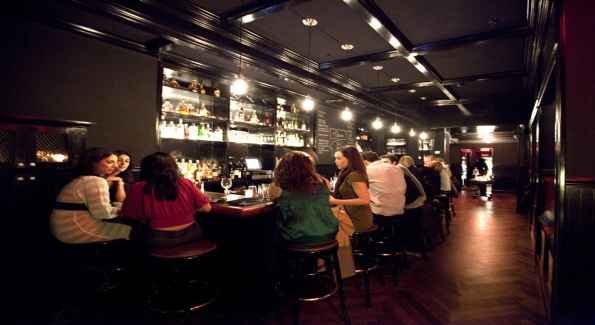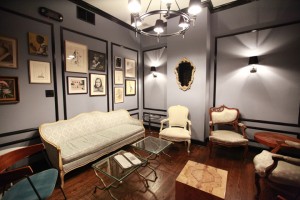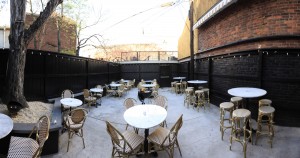If you haven’t been back to The Gibson in awhile, three distinct spaces (and cocktail menus) under one roof are more than enough reason to belly up to the bar.
By Kelly A. Magyarics
When The Gibson (2009 14th Street NW, 202.232.2156) opened a few years back, its sleek and sexy vibe and off the hook creativity in the shaker took DC’s cocktail scene by storm. Though mixologist and cocktail consultant Derek Brown, who helped to launch the bar’s concept, departed last fall to open up joint venture The Passenger and Columbia Room with older brother Tom, The Gibson remains in the more than capable hands of mixologist Jon Harris. What else has changed besides the back bar lineup? “While we’re still kind of a classic cocktail joint as we were when Derek was here, the majority of the menu is comprised of original recipes,” he says. “So, the style has changed considerably.” Recently, Harris dished about The Gibson’s expansion (three rooms, three different drinks menus,) what’s going on in the kitchen (they’ve hired a chef for small plates Tuesday through Saturday,) and how Dolcezza Gelatos fit into the latest bar concoctions.
How has the Gibson morphed and changed since its opening?
Obviously everything is just bigger. Two floors in the fall, winter and early spring, and three when the patio opens for the summer. The menus are longer, too. We started out with about ten drinks on our first few menus, and the Black Bar menu remains a little more complex as we try to push the creativity of cocktailing forward. While we’re still inspired by classic cocktails, we mostly now use that as a base for originality, so a lot of what you get here is unlike any drink you might have had, you won’t get it elsewhere, and it’ll only be available here for a limited time. Otherwise, I’m pushing for Gibson to be less of a “cocktail bar” and more of a drinking establishment. I think we may have earlier frowned on folks who just wanted wine, beer or a slug of whiskey instead of our “specialty cocktails”, but I don’t think there’s anything wrong with that.
Talk a bit about the difference in vibe, clientele, drinks and atmosphere among the three bars.
The Black Bar is the most formal. The tables are reservation only through 11:30 PM, so it’s for people who plan ahead and want to ensure that full Gibson experience. We do accept walk-ins for the bar stools downstairs, but particularly on the weekends, there’s likely to be a long wait for those seats after around 8 PM. The menu in the main bar is much more progressive than it’s ever been—I’m treating it as our tasting room. There are a few classics on the menu, but the vast majority are originals, like the Mary Trevelar, which comes out with a smoldering cinnamon stick for garnish; or cocktails made with our house made quince ratafia or sandalwood tincture. Guests may also see bartenders wielding blowtorches and cracking eggs. With its wide array of ingredients, the Black Bar is where it’s easiest to order drinks that aren’t on the menu.
The White Bar upstairs is more for the walk-in crowd. It opens at 8 PM, and only on Friday and Saturday, and provides another option for guests who just want to grab a drink but don’t necessarily have to have a seat at the bar downstairs. It’s fairly casual—the bar area tends to be a little quieter, there are couches to lounge on in the two rooms upstairs, and we allow standing here as well (standing isn’t allowed downstairs or on the patio). The drinks take less time to make than those downstairs. Right now we’re featuring Old Fashioneds and Slings, which the bartender can quickly builds in the glass and garnish as necessary. The quickness of the drinks is not a loss of quality—they still have the same fresh ingredients and proper technique. The menu for the White Bar will likely continue to be classically focused, so after we feature the Old Fashioned and the Sling, we’ll probably focus on another category of classic drinks, like Crustas. While the White Bar is mainly for walk-ins on the weekends, it is also always available for private parties. Since we only accommodate six people downstairs, someone who wants a larger gathering can rent the upstairs bar, a room, or the whole floor.
The patio is open in summer, when people want to be outside, and is built for larger groups that skew a bit younger than our other bars, especially on the weekends. The drinks here are built for the heat, so most are served on ice, fairly light and meant to be summer refreshers. We also do most of our punch service outside since those are built for larger crowds and can be shared with no fuss with friends on a breezy (or stifling) summer evening.
What are some of your favorite ingredients to work with right now?
I’m enjoying using liqueurs and bitters as bases right now. On the previous menu we had the First Go Round Fizz, which used Cointreau as a base and half an ounce of Angostura Bitters to balance the sweetness. Then there’s the Mynah, which balances super-sweet Yellow Chartreuse with the tanginess of sloe gin and a dash of bitters. Those are fun because there aren’t many drinks like that and they pack an almost jarring flavor wallop you wouldn’t get using traditional base spirits. I also enjoy floral aromas like orange flower and rose waters, our house made lavender bitters and saffron bitters. I just like the ethereality these impart. They’re like the overtones you get when you play a chord in music, floating over the top of the notes that make up the chord. And of course I like making my own ingredients whenever possible. I love the Quince Ratafia we’re using here. It’s delicious on its own and makes a brilliant cocktail.
Name some of the most popular cocktails. What are good “starter” drinks for guests not so familiar with cocktails?
The most popular cocktails are the Old Fashioned and the Sazerac. The Aviation is also a good starter to cocktails. The current top seller on the new menu is Bliz’s Royal Rickey, a drink by Tom Bullock published in 1917. It’s an elaborated Rickey, with Old Tom Gin, dry vermouth, raspberry syrup, lime juice and ginger ale, garnished with fresh berries and the shell of half a squeezed lime.
What about the floats? What inspired you to create this type of drink for the menu?
The floats are fairly popular. The inspiration came from an old drink called the Soyer au Champagne that we saw in Ted Haigh‘s Vintage Spirits and Forgotten Cocktails, that has Champagne, pineapple, maraschino liqueur, Cognac and vanilla ice cream. We updated it with an Angostura gelato to make a summer version of the venerable Champagne Cocktail.
There were also a couple of recipes from Thomas Keller and Heston Blumenthal that I wanted to translate into drinks, and the floats provided a great platform for that—I think they’d appreciate them since they both enjoy playing with form and texture. It was difficult to get Mascarpone cheese and beets into a normal, strictly classic-style drink, but turn them into gelato and it became a lot easier. That’s how we got the Fresh Laundry and the Slightly Odd Duck floats. Ultimately, it boiled down to playing with form and texture in drinks without all the molecular mixology stuff.
Recipes (courtesy of Jon Harris, The Gibson, Washington, DC)
La Belle et La Bête
Harris uses gomme syrup in this drink, which he says “provides a silky mouthfeel in drinks, affecting the way the flavors hit and lay on the tongue.” They also tend to be a little more stable than simple syrups, and keep longer. You can replace it with simple syrup infused with fresh pineapple.
2 oz. Bison Grass vodka (like Zubrowka)
2-3 dashes pineapple gomme syrup
1 dash Angostura bitters
1 lemon peel
Build in a double rocks glass. Add a large ice ball or cracked ice. Stir well to chill.
Black Roses
Cachaça is a highly underutilized spirit in the cocktail world, Harris believes. Here, he combines it with floral elements Crème de Violette and rose water for a vase-to-glass aromatic libation.
1 ½ oz. Leblon Cachacha
1 oz. Dolin Rouge
½ oz. Crème de Violette
1 dash Angostura bitters
1 dash rose water
Cherry, for garnish
Add all to a cocktail shaker filled with ice. Stir well, and strain into a chilled cocktail glass. Garnish with a cherry.
Kelly Magyarics is a wine and spirits writer, and wine educator, in the Washington, DC area. She can be reached through her website, www.kellymagyarics.com, or on www.twitter.com/kmagyarics.



